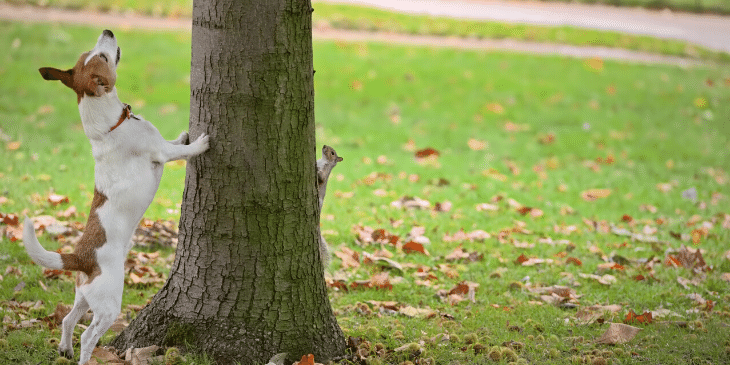What To Do When Your Dog Chases Squirrels and Other Small Animals

Contents
Although most dogs enjoy the chase, some dogs have an extremely high prey drive. Dogs are natural predators and scavengers, and even though we think of them as domesticated, they still have a natural instinct to hunt.
If your dog is a hunting or herding breed, such as a German shepherd, terrier, or border collie, he’s especially likely to chase squirrels and other small animals. Many dogs will relish the opportunity to go after cats, rabbits, and even birds. It’s not uncommon for dogs with a high prey drive to catch and kill animals like baby bunnies, which can be especially upsetting for dog owners.
Thankfully, there are some things you can do to correct this common dog behavior, or at least minimize it and redirect your dog’s attention elsewhere. Dog training techniques such as basic obedience will also be helpful for when you’re walking your dog and encounter squirrels and other small animals in your neighborhood.
Let’s talk about why your dog chases other animals, and what you can do to get this instinctual dog behavior under control.
Why Does Your Dog Chase Squirrels and Other Small Animals in the First Place?
Your dog’s prey drive probably plays a key role in his squirrel chasing habits. But for some dogs, chasing things is just plain fun! They don’t even care if they catch the animal or not. All it takes is the movement of a cat, squirrel, or bird to have them off and running. If there’s a critter on the run, some dogs just can’t resist the urge to chase after him.
How to Get Your Dog’s Natural Instinct to Chase Squirrels and Other Critters Under Control
Here are some dog training tips and tricks you can use to get your pooch to stop chasing cats and wildlife.
Manage Your Dog’s Behavior With a Leash
The first thing you should do is use a leash whenever you’re somewhere that you’re likely to encounter other animals. The last thing you want is for your dog to chase after a squirrel and run out into the road.
Leash walking keeps your dog under your control and safe while you work on correcting his behavior. It also ensures that he doesn’t get the chance to catch and harm a small animal.
Consider Putting a Bell On His Collar
If your dog has the run of the back yard, you can give other animals a chance to escape by putting a bell on his collar. The noise will alert other animals that your dog is coming before he has the chance to catch and harm them.
Walk Him at a Different Time of Day
Changing your walking schedule can be very helpful. Small animals like squirrels, rabbits, and birds tend to be most active at dawn and dusk, so you might try taking your walk a little later in the morning or a little earlier in the evening. This simple change might be enough to avoid the animals your dog wants to chase and make your walks much more enjoyable.
Make Your Yard Less Tempting to Wildlife
If you’re struggling to keep your dog from killing small animals in your backyard, it’s probably a good idea to make your yard less inviting to wildlife in the first place. If you have bird feeders out that are drawing in birds and squirrels, consider removing them for the animals’ safety.
Provide Plenty of Exercise and Mental Stimulation
Dogs with a high prey drive usually have a lot of energy. Burn off your dog’s energy with long daily walks, active games like fetch, and trips to the dog park (as long as he gets along well with other dogs).
If you’re not available or physically able to walk your energetic pooch as much as you would like, consider hiring a dog walker to burn off his pent up energy.
A bored dog is also a lot more likely to chase squirrels than one who has lots of mental stimulation. Try providing your pooch with interactive dog toys and other activities, such as hide-and-seek or agility, to exercise his brain, too.
Walk Him After a Meal
Walking your squirrel chasing dog when he’s hungry is just asking for trouble. Providing a meal before you head out for his daily walk might be enough to lower his motivation to chase.
Provide a Different Outlet for His Natural Prey Instinct
Dogs use their sense of smell when the hunt, so try hiding some treats around the house to give him a different outlet for his natural prey instinct. The interactive toys mentioned above are also much more engaging than plain dog chews or squeaky toys, and they provide a great outlet as well.
Learn How to Read Your Dog’s Body Language and Redirect His Attention
Learning how to read your dog’s body language when you’re out and about is also a good idea. If you notice your dog staring at something, stiffening up his body, or shaking with excitement, chances are he’s spotted something he wants to chase. When this happens, there are some techniques you can use to redirect your dog’s attention.
Start by taking advantage of your dog’s sense of smell. Keep some extra special treats in your pocket and pull one out when you want to redirect your dog’s attention. Hold it in your hand and use it to keep your dog focused as you walk past the temptation.
This may not work if your dog is overly excited, so try practicing it in less challenging situations at first.
Teach Your Dog to “Leave It”
Teaching your dog the “Leave It” command is invaluable for dogs who love to chase squirrels and other small animals. This command can be used to stop your dog from giving chase in the first place, and it can also be used to get your dog to drop an animal should he manage to catch it.
Teach Your Dog to Come When Called
Of all the commands your dog should learn, this one is most important. If your dog comes when called, a simple “Come” should get him to stop chasing an animal and return to you. Be sure to use tasty treats as a reward when training to up the incentive.
Use Noise Aversion
If all else fails, noise aversion can be used to dissuade a dog from chasing animals by creating a negative association with the behavior. This method involves making a loud noise by clapping, blowing on a whistle, or shaking a can filled with rocks the moment your dog shows interest in giving chase.
With consistency, your dog will begin to associate the behavior with the unpleasant noise. The idea is to grab the dog’s attention and discourage the behavior.
Some Final Tips
Keep in mind that subduing and redirecting a dog’s prey drive requires patience and consistency. It’s not something that will happen overnight. Start by practicing the techniques above in low distraction scenarios before you try them in areas where animals he likes to chase are found.
